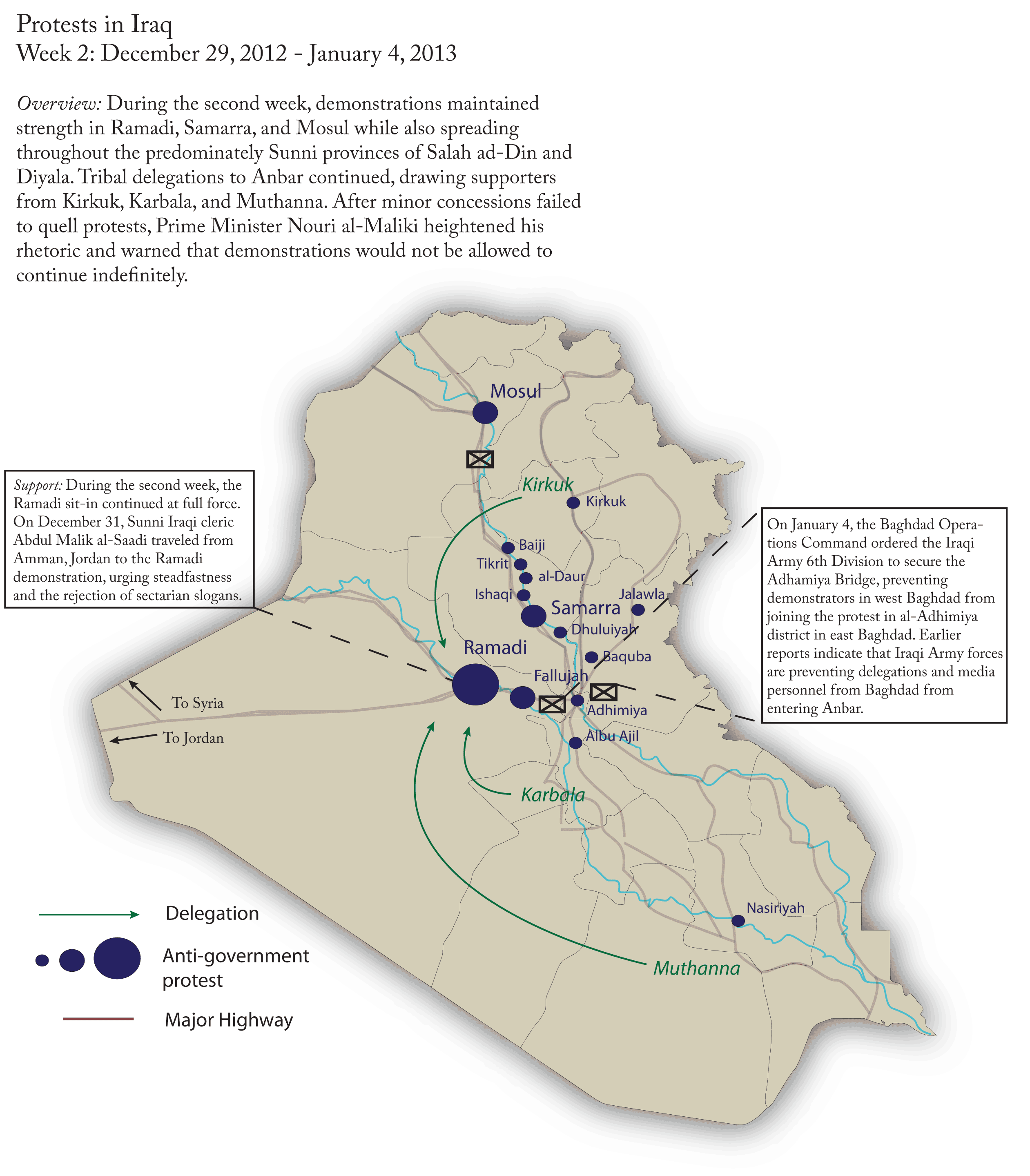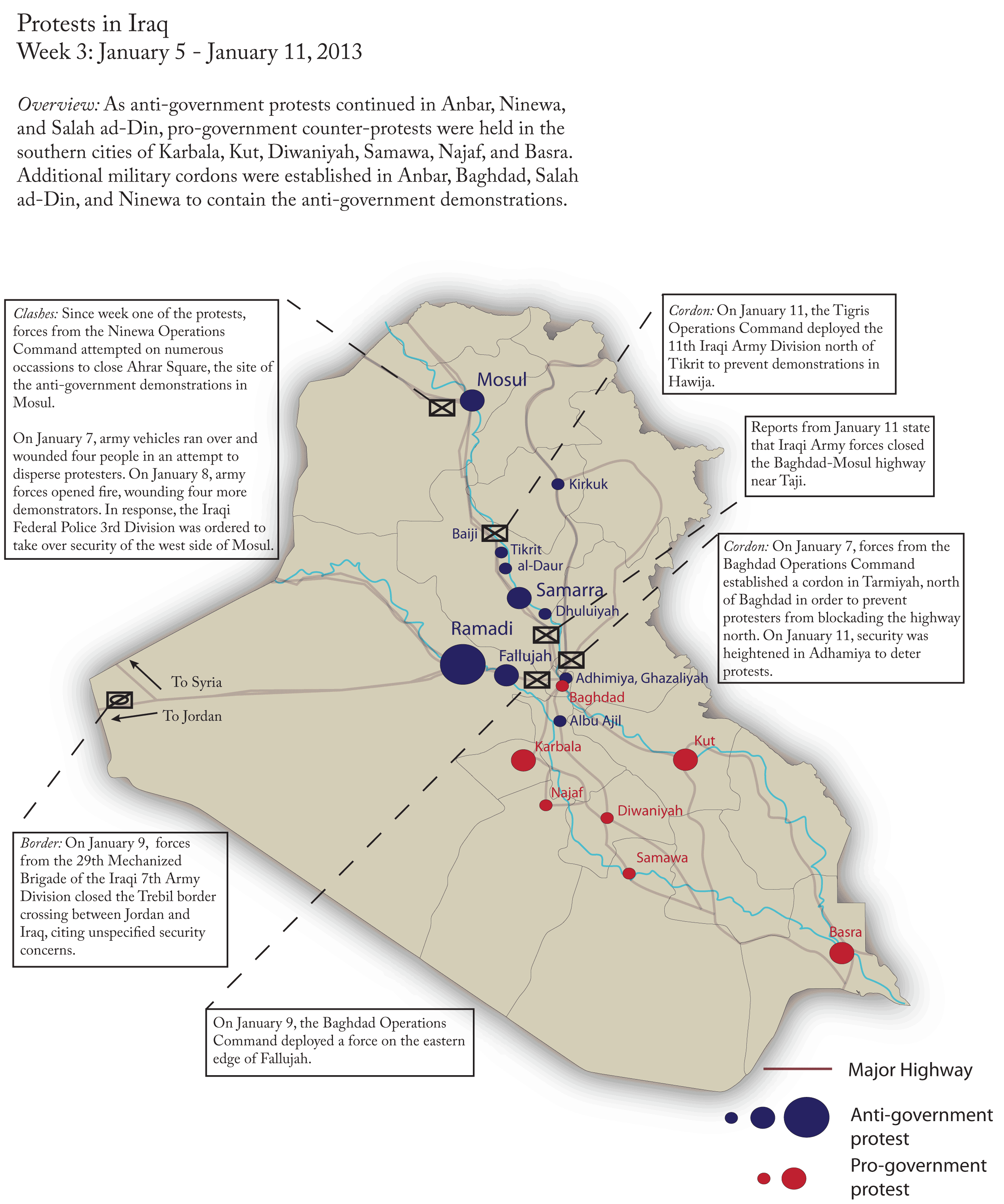 |
 |
Political Update: Mapping the Iraq Protests
Over the last three weeks, both anti-government and pro-government demonstrations have spread across Iraq, split geographically along sectarian lines. The graphics below depict where anti-government protests first erupted and how they have steadily spread throughout predominantly Sunni areas north and west of Baghdad. After two weeks of anti-government demonstrations, pro-government counter-protests emerged in the southern predominately Shi’a provinces. The geographic split of the movements is both a factor and an accelerant of sectarian tensions in Iraq.
Figure 1- Click to enlarge
The arrest of Iraqi Finance Minister Rafa al-Issawi’s security detail on December 20, 2012 sparked anti-government protests in his native Anbar province, which quickly spread to Salah ad-Din and Ninewa. Figure 1 depicts the protests that occurred between December 21st and December 28th. Throughout the first week, tribal delegations traveled from Salah ad-Din, Diyala, Baghdad, Maysan, and Basra to Ramadi, which has become the focal point of the anti-government movement. Tribes, religious organizations, People’s Committees, and provincial councils from Anbar, Salah ad-Din, and Ninewa have voiced their support for the anti-government protests. These groups may be providing food and other supplies to help sustain the sit-ins in Ramadi, Samarra, Tikrit, and elsewhere, but there is no direct evidence of how the demonstrations are being sustained and organized.
Figure 2- Click to enlarge
As they continued into their second week, the anti-government protests spread to over a dozen towns in Anbar, Salah ad-Din, Ninewa, Baghdad, and Diyala, as depicted in Figure 2. During this time, tribal delegations continued to arrive from other provinces such as Kirkuk, Karbala, and Muthanna. During the third week, protests were concentrated primarily in Anbar, Salah ad-Din, and Ninewa, with smaller demonstrations in Diyala and Baghdad. Despite small anti-government protests in Albu Ajil in northern Babil province and Nasiriyah in Dhi Qar province, the anti-government movement has failed to gain traction in the south, likely due to the predominately Shi’a demographics of the southern provinces.
The sectarian dynamics of Iraq play an important role in understanding the geographic concentration of the current anti-government movement. The predominantly Shi’a provinces of the south have distanced themselves from the movement, seeing it as a sectarian issue. Moqtada al-Sadr, the leader of the Shi’a political organization the Sadrist Movement, has voiced cautious support for the demonstrations, but has thus far not mobilized his supporters to participate. In contrast, anti-government protests against poor service provision occurred in the south during the Arab Spring in 2011, driven largely but not exclusively by the Sadrist Trend.
Figure 3-Click to enlarge
Pro-government demonstrations began in the south on 4 January, as depicted in Figure 3, after two weeks of sustained anti-government protests. They are being organized in part by Shi’a political parties, especially by Iraqi Prime Minister Nouri al-Maliki’s State of Law Coalition. As a result, these protests have a much more structured organization, with pro-Maliki groups, political leaders, and provincial councils advertising specific dates for protests throughout the southern provinces. The protests are becoming increasingly sectarian because of the geographic areas in which they are occurring and the political orchestration behind them. The growing sectarian perception of the anti-government protests augments Prime Minister Maliki’s position by solidifying Shi’a support in the south.
Maliki’s political alliance and other political actors have been able to define the movement in stark sectarian terms by accusing Sunni demonstrators of provoking sectarian tensions, particularly the use of Baathist flags in some demonstrations. Maliki has framed the demonstrations as a zero-sum situation: If the Sunni protests gain ground, Shi’ites will lose dominance in government.
Maliki has used Iraqi security forces to contain or disperse the anti-government protests only in limited ways so far. During the first week of protests, reports suggest that a brigade from the Ninewa Operations Command established a cordon near Mosul to prevent convoys of supporters from reaching the anti-government demonstration in the western part of the city. The following week, further reports indicate that the Iraqi 6th Army Division under the Baghdad Operations Command was used to block the Adhamiya Bridge in Baghdad to prevent demonstrators from joining the protest in Adhamiya, a Sunni enclave in east Baghdad. The Anbar Operations Command also deployed forces to prevent movement west towards Fallujah and Ramadi during the second week. Reports suggested that the Baghdad Operations Command established a cordon of Sunni areas north and west of Baghdad. Then on January 9th, the 29th Mechanized Brigade from the Iraqi 7th Army Division assisted in closing the Trebil border crossing between Iraq and Jordan. Most recently, additional cordons have been established near Tikrit and Taji in Salah ad-Din.
Violent clashes between anti-government protesters and Iraqi security forces have been limited to Mosul as of January 11th. The first reports of violence came during the third week of the protests, when forces from the Ninewa Operations Command overran and fired on protesters near Ahrar Square in Mosul in two separate incidents, wounding eight. Extrapolating from Maliki’s responses to anti-government demonstrations in 2010 and 2011, the Prime Minister will likely steadily increase the presence of security forces in cities, while simultaneously promising minor concessions and stoking fears of terrorist plots. Whether and how Maliki may use force against protests in Anbar, however, remains to be seen.
Numerous groups have already pledged to react violently to any use of government force. Maliki’s response, therefore, will likely be restrained and focused on cutting economic and logistical lines to Anbar in order to reduce the size and sustainability of the demonstrations. The recent troop deployments to the north and west of Baghdad and the closure of the Iraq-Jordan border suggest that this strategy is already underway. The Anbar provincial economy relies heavily on cross-border trade with Jordan. This approach carries risk. Placing additional economic constraints upon the Sunnis as well as politically isolating them may radicalize a population already mobilized by legitimate grievances.
If anti-government protests continue to grow and ultimately provoke a violent response from security forces, anti-government sentiment will likely expand quickly, legitimately threatening Maliki’s hold on power. If, however, Maliki is able to contain the anti-government demonstrations in their current locations and erode support for them over time, Maliki will emerge with solidified support in the south and a much weaker opposition in the north.


